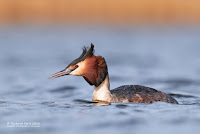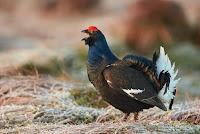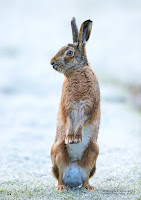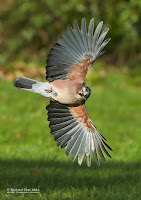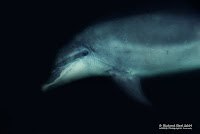After a 90 minutes drive, we arrived at the site and three things were immediately obviously. Firstly the lake level was much higher than usual and our favourite spot to photograph the birds, a concrete jetty set just above water level, was under about a foot of water. Secondly the sun was well and truly blocked out by a long line of cloud that seemed to be developing as it was pushed up over the hills and thirdly there was not a single Goosander to be seen. Not a very promising start!
A close view of a female to show why they are called sawbill ducks.
So we waited and waited and were just thinking about perhaps looking somewhere else on this large elongated lake when a pair of birds flew in. The sun was still stuck behind the stubborn bank of dense grey cloud. We starting taking some photographs but the male birds with their dark heads with its iridescent green sheen really do benefit from a bit on sunlight.
Far in the distance the clouds seemed to be breaking and a patch of blue sky, which was heading our way, was opening up. At the same time a second pair of birds arrived. The situation was definitely improving fast and even the lake levels seemed to be dropping from its flooded state. Before long the blue sky was by us and the sun appeared and it looked like we were to have a prolonged period of good light ahead.
Preening male.
and preening female.
We had been photographing the birds for around 10 minutes when there was a loud bang, followed by another and another and another which was echoing around the hills. My first thought was that may be there was shooting party up on the hillside somewhere. The banging continued and seemed to be getting closer. With each successive bang the Goosander were obviously getting more and more unsettled. Then the source of the noise appeared which was a 'customised' small car which was constantly backfiring which was travelling down the road along the edge of the lake. By the time it had reached us, still backfiring constantly, the Goosander had heard enough and all four took off at high speed towards the far end of the lake. How typical, we had patiently waited for it all to come together only to then fall apart in an instant due to a passing poorly modified car. We could hear the car as it was driving around in the nearby town, bang, bang, bang before it eventually fell silent presumably due to the owner parking.All we could do was wait once more to see if the Goosander would return. This gave Steve time to have a play with his new Canon 7Dmk2 and get a better feel for the autofocus with some flying mallard. As we waited for the Goosander we said that knowing our luck the birds would return and the back-firing car would come back through just as they arrived. We waited some more. Eventually one pair of birds returned. They had been there for around 5 minutes when from the town behind we suddenly heard in the distance bang...bang...bang..as the car started back up. We looked at each other in disbelief, surely we wouldn't be twice unlikely which fortunately we were not. However, by this time the patch of blue sky was rapidly closing up once more into dense cloud with no obvious signs into the distance of improvement. So once the sun disappear for the last time we decided to bring the session to an end.
A rare exit from the lake.
One the final photographs in the afternoon before the sun disappeared behind cloud for the last time
It was one of those trips where you think you have not come away with many photographs but I was pleasantly surprised when I got home and went through them. We had obviously worked hard in the moments when we had both sun and birds in front of us. Overall it was an enjoyable day out and a great way to start our photography in 2015.

































